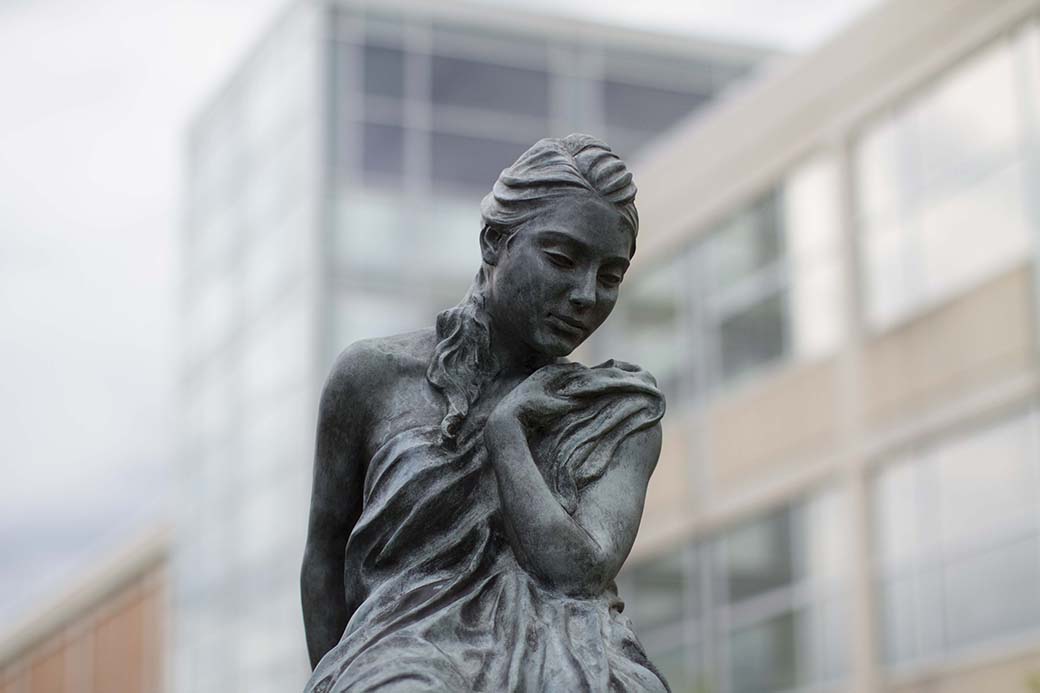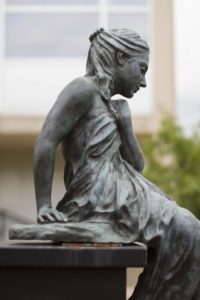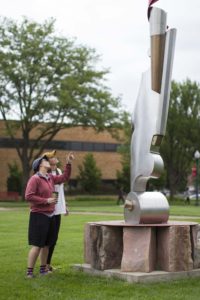
New sculptures on campus ‘something to be very proud of’
Campus gained seven new works of art over the summer.
The on-campus sculptures were placed by SculptureWalk, a nonprofit based in downtown Sioux Falls, where displays are rotated annually.
“I do a special call to sculptors for USD and Vermillion,” said Jim Clark, director of SculptureWalk. “They have committees and select their sculptures for a two-year period.”
At the end of the two-year period, artists submit more entry forms and the process starts all over again.
As important as the SculptureWalk is for the city of Sioux Falls, Clark said Vermillion is a unique spot for sculptures.
“The sculptures add a beautiful, artistic element and draw people to the beautiful campus and into the historic downtown,” he said. “There are only a handful of universities or communities around the country that have the leaders with vision and drive to accomplish a wonderful sculpture program like you have at USD and in Vermillion. It’s something to be very proud of.”
First-year Arenne Marksbury, a communication disorders major, said the new artwork creates a more exciting atmosphere on campus.
“(The sculptures) bring a lot more publicity (to the university) and every two years it’s a new (sculpture). The university is always new and improving rather than staying the same, which can get boring,” she said.

Finding inspiration
The artists featured on campus are from around the world. Canadian artist Donna Mayne created “Brenna,” a sculpture located near the Muenster University Center and I.D. Weeks Library.
Mayne said “Brenna” is a part of a series called “Gift of Water,” and showcases how important water is as a life source.
“Each of the figures is seen in a contemplated gesture of reaching out and touching water either with their extended fingers or toes. I volunteered for several years as a safe water advocate here in Windsor,” Mayne said. “It was kind of my outlet for creating a public awareness type of art that hopefully inspires people feeling that they need to pay closer attention to how fragile our environment is.”
Mayne led groups of artists to create more than 40 public mural sites and now creates artwork that focuses on the life source of water.
“If you look at ‘Brenna,’ she is contemplative, she’s tranquil, she looks like she is appreciating what she is doing,” she said. “That is my message: Appreciate this life source, realize that we have a finite amount of natural resources and to be careful with them.”
Mayne said she was happy to find SculptureWalk as a way to display her sculptures in a public space.
“I researched online and found (SculptureWalk) and since then I have participated in other sculpture venues and I just want to say that you guys are very fortunate to have a well-orchestrated system there,” Mayne said. “(SculptureWalk) helps the community, it helps the artist and it enriches everybody.”

Another sculpture on campus is “Architrave” by Dan Perry, a University of Northern Iowa professor. The sculpture is located between the Al Neuharth Media Center and the Beacom School of Business.
Perry said the purpose of “Architrave” is to pull elements from Beacom, Neuharth and the Law School.
“(USD is a) beautiful campus. What I liked about that particular sculpture in the triangular quad area (was that) it has three different buildings, three different architecture styles,” Perry said. “I took those elements and sort of extrapolated them and stretched them out and put them together. I thought it looked really nice and complemented the different buildings in the area from each angle and it works with each one of those buildings in a different way and engages with the space.”
Other sculptures that are new to campus include “Reaching for the Stars,” “Time to Fly,” “Blue Heron” and others.
Perry’s artistic vision is to have the observer feel as though they’re part of the sculpture.
“I want (my work) to be visually dynamic enough (that) every time someone engages it, they see something a little different. The light might catch it a little differently, they might see a different view, it might make more sense one way or the other,” he said. “A lot of times with public art, it’s hard to see what’s going on at first because it’s so new and your body is trying to process what’s going on there. I want it to be something that changes with time.”

